


5.1. The formation and evolution of galaxy clustering
The question of the origin of clusters of galaxies was addressed as soon as the extragalactic nature of nebulæ was established. In 1927 Lundmark [287] suggested that clusters could form through many subsequent galaxy-galaxy encounters. These encounters would lead to a loss of the orbital energy of the galaxies, which would then form a bound system. Nine years later, the theory had not progressed much, and Hubble [233] was unable to be very specific on this topic:
``condensations in the general field may have produced the clusters, or the evaporation of clusters may have populated the general field.''
The different velocity dispersions of cluster and field nebulæ led however Zwicky [513] to reject the latter of Hubble's possibilities. He also considered extremely unlikely that the rich, regular, centrally concentrated clusters could be just an effect of geometrical chance alignments of galaxies along the line-of-sight. His favourite scenario was that of Lundmark [287]. By requiring the mass of cluster galaxies to be higher than the mass of field galaxies, gravitational clustering could be made more efficient. The large cluster virial masses obviously seem to support this view. Despite the large masses implied for cluster galaxies, Zwicky however realized that the formation of great clusters by subsequent capture of field galaxies would take a very long time, much larger than the age of the Universe. In 1943, by using Chandrasekhar [103]'s theory of dynamical friction, Tuberg [463] indeed estimated the cluster relaxation timescale to be 1011-1012 years, i.e. orders of magnitude larger than the estimated age of the Universe at that time.
In 1941, Erik Holmberg [226], a supporter of the capture theory for cluster formation, published his remarkable paper A study of encounters between laboratory models of stellar systems by a new integration procedure. Two decades before the first n-body numerical simulation of von Hoerner [488], Holmberg ideated an ingenious device to simulate galaxy-galaxy encounters. His idea was bright and simple: gravitation was replaced by light in his model. The mass elements (37 per stellar system, set in circular annuli on a plane) were represented by light-bulbs, the candle power being proportional to mass. By modulating the bulb candle power with the distance from the centre of the system of bulbs, Holmberg was able to simulate a given density profile. The two stellar systems were given a certain approach velocity, and were also set in rotation. All measurements were performed on a plane surface, so that the simulation was 2-dimensional. The acceleration on a given element was measured by integrating the light at the position of that element with a photocell. The light bulb was then moved accordingly.
Holmberg's results were very interesting. By looking at Figure 4 in his paper - here reproduced in Fig. 29 -, we can see clear evidence for the tidal features that Toomre & Toomre's [462] n-body simulations reproduced only 30 years later. Holmberg however mistook tidal features for spiral arms in the process of formation. Moreover, even if ``in favorable cases, captures may occur'', the experiment essentially ruled out the capture theory for cluster formation (which was Holmberg's favourite scenario).
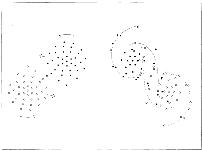
|
Figure 29. Results of the simulation of a collision between two nebulæ. Left panel: two disky galaxies approaching. Right panel: after the collision. From Holmberg (1941). |
In 1952 and 1956 Zwicky [520, 523] remarked upon the similarity of distant and nearby clusters. This lack of evolution seemed difficult to reconcile with an expanding Universe. Zwicky was trying to rule out Hubble's expanding Universe, because its short age was clearly inconsistent with the long dynamical timescales he thought necessary to build the rich regular galaxy clusters. Detecting the evolution of the cluster number density was to prove very difficult. Some observational evidence in this sense was claimed by Just [245] in 1959, by Paal [344] in 1964, and by Rowan-Robinson [393] eight years later. Rowan-Robinson however warned against possible selection effects that could have biased his result. The preferential selection of the richest clusters as spectroscopic targets was shown by Reaves [370] to account for the evidence for evolution. Anyway, these first attempts opened the way to modern investigations of the cluster number density evolution (see, e.g., Borgani et al. [77]).
In 1961 van Albada [472] performed a numerical integration of a model for the cluster evolution, and draw the first modern scenario of cluster formation:
``Clusters can be formed by gravitational amplification of statistical density fluctuations in an initial homogeneous field of galaxies''
In 1963 Aarseth [1] performed the first of a long series of n-body simulations of galaxy (or stellar) clusters. His first simulations contained at most 100 point-masses. Twenty years later, thanks to the advances in computer technology, Miller [306] could run a 105-body simulation. The increase rate of n in n-body simulations over the last thirty years is described in MOORE (these proceedings).
One year later, Hénon [211] performed numerical computations of the dynamical mixing in spherically symmetric clusters. He noted that phase-mixing rapidly leads to a steady-state configuration after the initial system contraction. He prepared the field to Lynden-Bell [288]'s milestone paper Statistical mechanics of violent relaxation in stellar systems, published in 1967. Lynden-Bell showed that:
``the violently changing gravitational field of a newly formed galaxy is effective in changing the statistics of stellar orbits [which] in the relevant limit [...] becomes Maxwell's distribution but with temperature proportional to mass''.
Lynden-Bell showed that the predicted density distribution approached the modified isothermal sphere, or King [255]'s recently published distribution. Violent relaxation removes the need of very long timescales for a cluster to reach stable, relaxed dynamical configurations. Lynden-Bell's results was confirmed by Peebles [350]'s 300-body simulation of a Coma-like cluster. Peebles showed that 10 Gyr suffice to form a rich symmetric cluster - see Fig. 30.
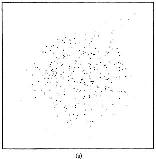
| 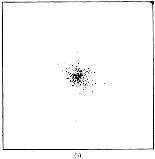
| ||
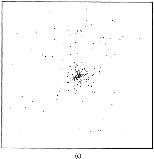
| Model 1 positions: (a) initial positions, t = 2.8 b.y.; (b)
t = 5.6 b.y.; and (c) Figure 30. 300-body numerical simulation of the Coma cluster, at three different times (increasing from panel a to c). From Peebles (1970). | ||
The cluster collapse and subsequent infall of material into clusters were theoretically examined by Gunn & Gott [200] (see also Sections 5.2, 5.3, 5.4). They were probably the first to remark that ``the present is very much the epoch of cluster formation''. Their statement was based on the idea that the many existing irregular clusters were still in a pre-collapse phase. This idea was later developed by Richstone et al. [374], who saw the possibility of constraining the density of the Universe by estimating the fraction of substructured (i.e. irregular) clusters. Oemler [331] also elaborated Gunn & Gott's idea by identifying the irregular clusters with the spiral-rich, and the regular, evolved ones with the cD-type, which ``must have begun as the densest fluctuations in the early Universe''.
Between 1965 and 1975, two opposite scenarios for the formation of structures were developed, mainly by Peebles [349], Peebles & Dicke [355], Silk [421] and Gott & Rees [189], on one side, and Zel'dovich & Syunyaev [509, 441, 443] on the other side. Peebles and collaborators advocated for a hierarchical bottom-up formation of the galaxy structures, while Zel'dovich and collaborators developed a theory for the evolution of large density perturbations leading to a top-down scenario, with the formation of galaxies from fragmentation of pancakes. In their original purely baryonic versions, the hierarchical scenario predicted an evolution of structures from isothermal primordial density fluctuations, while in the top-down scenario the primordial fluctuations were adiabatic. The bottom-up scenario was soon proven by Aarseth & Hills [5]'s simulations to be a viable scenario for the formation of a cluster via the merging of separate subclusters. It then received a formidable support from Press & Schechter [363]'s 1974 paper Formation of galaxies and clusters of galaxies by self-similar gravitational condensation. Press & Schechter obtained their famous mass function, and compared it with observations, finding ``rather striking agreements'' (see Section 4.3). Also the Russian pancake theory (with the added ingredient of massive neutrinos - see Klinkhamer & Norman [259]) had many supporters. As an example, Thompson & Gregory [454] argued that Coma is ``a Zel'dovich disk''. The popularity of the model started to decline in 1983, when Frenk et al. [169] showed it implied a very late formation of galaxies, much too late to reconcile with observations. In the end, a hierarchical structure formation from primordial adiabatic density fluctuations has emerged, a sort of compromise between the two original scenarios, where the Zel'dovich approximation is still valid for describing the initial evolution of structure on large scales, and cold dark matter plays a leading role in shaping the structure of the Universe (Bond et al. [76]).
In 1976, further support to the hierarchical clustering scenario came from White [491]'s 700-body simulations. He showed that ``clusters form by the progressive amalgamation of an inhomogeneous system of subclusters''. The direction of the final major merger defines the direction of the cluster elongation, and there is no need to invoke cluster rotation or tidal distortions to explain the cluster elongations - see Fig. 31. Following White's result, Forman et al. [165] interpreted the double structure of some X-ray emitting clusters as an evidence for an intermediate evolutionary stage.
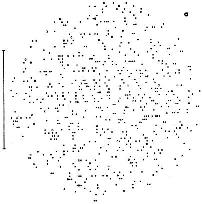
| 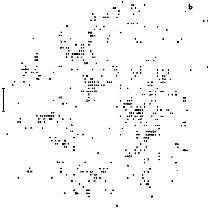
|
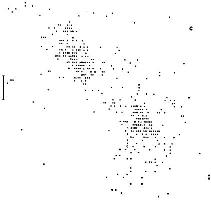
| 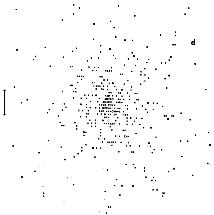
|
Figure 31. 700-body numerical simulation of a cluster, at four different times. From White (1976a). | |
In 1978 Fall [160]
reproduced the shape of Peebles' covariance
function in his 1000-body simulations. The following year, the
4000-body simulations by Aarseth et al.
[4]
not only confirmed
Fall's results, but also reproduced the recently discovered huge
voids [459,
195,
454,
449,
109,
448,
196]
in the galaxy
distribution. Aarseth et al. noted that if the Universe has
 0 = 1 ``the
clustering is proceeding at the present
time'', while this is not the case if
0 = 1 ``the
clustering is proceeding at the present
time'', while this is not the case if
 0 is low. An
0 is low. An
 0-dependence of the
covariance function was noted by Gott et
al. [191]
and Efstathiou
[151]
in their n-body
simulations. The cellular, filamentary appearance of the structure of
the Universe was reproduced in the 105-body simulations of
Miller [306].
0-dependence of the
covariance function was noted by Gott et
al. [191]
and Efstathiou
[151]
in their n-body
simulations. The cellular, filamentary appearance of the structure of
the Universe was reproduced in the 105-body simulations of
Miller [306].
The cluster number density evolution has now become a strong constrain
for cosmological theories. Most observational evidence of this kind
points to a low- 0
Universe (see BAHCALL, BORGANI,
these proceedings), and the extensive ongoing surveys will soon
improve the statistics and probe deeper in space (see, in these
proceedings, BARTLETT, B¨OHRINGER,
CARLSTROM, DICKINSON, GAL,
GIOIA, JONES, LOBO,
SCHUECKER, and ZARITSKY).
0
Universe (see BAHCALL, BORGANI,
these proceedings), and the extensive ongoing surveys will soon
improve the statistics and probe deeper in space (see, in these
proceedings, BARTLETT, B¨OHRINGER,
CARLSTROM, DICKINSON, GAL,
GIOIA, JONES, LOBO,
SCHUECKER, and ZARITSKY).